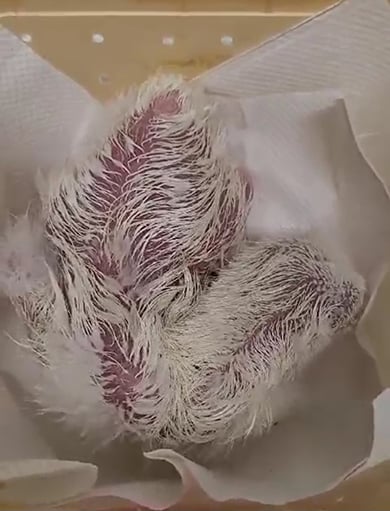Every year, the popular Royal Cam livestream broadcasts a toroa pair as they go from nesting to fledging a chick at the albatross colony, near Dunedin, providing insight into the lives of this special seabird species.
The livestream, run by the Department of Conservation and Cornell Lab of Ornithology, is now in its ninth year. Last season (running from 1 November 2022 to 30 September 2023) had 280,000 unique viewers tune in from all over the world.
DOC Biodiversity Ranger Sharyn Broni says the chick hatched on Tuesday, weighing a healthy 300 g. Like all chicks at the colony, it hatched in the artificial incubator to prevent flystrike, before being returned to its nest.
She says rangers are looking forward to a busy season at Pukekura after the colony's first chick hatched on 17 January.
"This is a critical time for us working at the colony as we manage potential issues such as flies and hot dry conditions, which are only likely to worsen through climate change."

Albatross/toroa chick born January 2024
Image: DOC | DOC
"For the safety of the chicks, we take any egg which has pipped - or begun to hatch - to the artificial egg incubators, which protects them from flystrike."
Flystrike is when flies lay maggots in the egg or on the chick, which can be fatal.
Sharyn says while the chick hatches, a dummy egg is slipped under the nesting parent until the chick hatches and can be returned to the nest.
"We also treat nests and young chicks with a bird-safe fly repellent to further reduce the chances of flystrike.
"Once the chicks are back with their parents, rangers weigh them regularly to ensure they are putting on weight as expected and supplementary feeding may be required in some cases.
"Heat is managed through a sprinkler system which cools the nesting birds to protect them from the scorching temperatures."
Sharyn says Pukekura is one of only four breeding sites for this taonga species, which is declining globally and has an estimated population of about 17,000.
Otago Peninsula Trust and Royal Albatross Centre Ecotourism Manager Hoani Langsbury says: "Royal Albatross Centre staff are very excited for this critical time of the toroa breeding cycle, which is second only to chick fledging when all the hard work pays off to grow the toroa population."
Te Poari o Pukekura chair Nadia Wesley-Smith says the hatching of the Royal Cam chick is celebrated along with all hatchings that herald the coming season.
"The Royal Cam is a wonderful mechanism in which to raise awareness of the toroa and the conservation efforts that goes into the colony at Pukekura/Taiaroa Head."
Background information
Since Season 1 in 2016, Royal Cam has had more than 4.2 million viewers from across 190 countries. Its largest audiences are from New Zealand, Australia and the United States.






